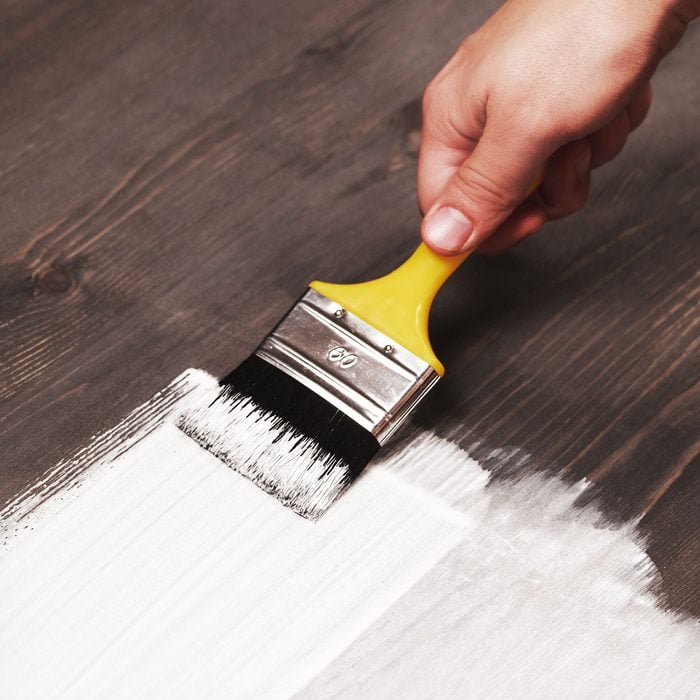Can You Paint Over Stained Wood?
Updated: Nov. 07, 2023

When it comes to painting, stained wood is virtually the same as bare wood, as long as you prime first to make sure the fresh paint covers evenly.
Yes, you can paint over stained wood. This shouldn’t come as a surprise, because wood stain is designed to be top-coated with a clear finish, and when it comes to adhesion, there isn’t much difference between paint and clear finish.
I’m a retired furniture finisher/refinisher, and I used to paint over stained wood all the time, but with an important caveat. If the wood already had a finish that was wearing thin or starting to crack or peel, I stripped or sanded it off before painting.
If I was planning to apply a new clear finish, I always sanded off all the stain down to the bare wood in preparation for restaining. If I was going to paint, I didn’t bother getting all the stain, because the paint covers the blotchiness.
On This Page
Can You Paint Over Stained Wood Without Sanding?
You generally don’t need to sand new wood that has been stained before painting, but it depends on the results you’re after. If you want a super-smooth painted finish, scuff-sand, which is lightly sanding (scuffing), the surface by hand (not with a machine), to smooth out bumps using 150- or 220-grit sandpaper.
This method works well, especially if you’re going to spray the paint. Scuff-sanding knocks down the wood grain that has been raised by application of a stain, especially a water-based stain, and smooths things out.
Sanding is more important if you’re painting old finished wood. If the finish is in good shape, an orbital sander and 150-grit sandpaper dulls and etches it and helps the paint adhere better. If you don’t like sanding, you can also use liquid sandpaper or a similar deglossing agent to dull the finish and improve paint adhesion.
If old varnish or lacquer isn’t in good shape, sanding with 120-grit sandpaper gets rid of the flaking and peeling finish, and because you’re going to paint, it doesn’t matter whether some of the stain comes off or not.
Can You Paint Over Stained Wood Without Priming?
It’s always advisable to apply a coat of primer to stained (or unstained) wood before painting. Primer helps seal knots and pores in the wood to provide more uniform paint coverage, which is something stain doesn’t do by itself.
Sometimes you may be tempted to skip the primer, particularly if you’re working with a close-grained hardwood like maple or oak, but that’s not a good idea. And there’s one particular instance in which you shouldn’t:
Suppose you have just completed a woodworking project. The wood is sanded and freshly stained, but you’re unhappy with the color, so you decide to paint. In this case, you might encounter bleed-through if you paint right away, especially if you cover an oil-based stain with latex paint. Bleed-through happens when some of the pigmentation migrates through the paint and discolors it.
There’s a simple way to handle bleed-through. Let the stain dry until it isn’t tacky, then apply a coat of stain-blocking primer. If you’ve already painted, and the stain is bleeding through, you can apply the primer directly over the dried paint. When the primer dries, apply a fresh coat of paint.
Best Paint To Cover Stained Wood
You can cover stained wood with pretty much any type of paint, including:
- Latex and acrylic latex.
- All-in-one paint and primer.
- Alkyd (oil-based) paint.
- Milk paint.
- Interior and exterior enamel.
- Lacquer and shellac.
- Spray paint from a can.
It bears repeating that the stain has to be dry. Some stains form a thin film on the surface of the wood, and these may contain varnish that needs to cure for a day or two after the stain is dry to the touch.
How to Apply Paint Over Stained Wood
If you want to paint old furniture or cabinetry with an existing stain and finish, it’s important to remove any furniture wax or polish first. Some polishes contain silicone, which will make the paint bead and separate (which is a condition called fish eye!). You can tell if wax is present because you can scrape it off with your fingernail or a coin. To test for silicone, spray water on the surface, and if it forms beads, the test is positive. Check out these tips to lighten stained wood.
Clean the wood
The amount of cleaning depends on the condition of the wood. New wood needs very little cleaning or none at all, while exterior wood may need a thorough cleaning with soap and water to remove mold. If there’s wax on the surface, remove it with fine steel wool and mineral spirits. Silicone is difficult to remove, but you should be able to get most of it by scrubbing with an abrasive cleaner such as Ajax or Barkeeper’s Friend.
Sand or degloss
Scuff sand by hand to smooth new wood or use a sander to remove flaking finish from old wood. If an old finish is in good shape, you can degloss it with liquid sandpaper in lieu of actually sanding.
Make repairs
Fill holes, tighten joints and make other necessary repairs.
Apply primer
Apply a coat of primer. If you think bleed-through may be a problem, use a shellac-based stain-blocking primer. Otherwise, any top-quality, high-solids primer will work. Give the primer about an hour to dry, then scuff lightly by hand with 220-grit sandpaper.
Paint
Apply one coat of paint by brushing or spraying. Let it dry for an hour or two (depending on the paint — check drying time on the container), then scuff with 220-grit sandpaper and apply a second coat. A third coat is optional.
